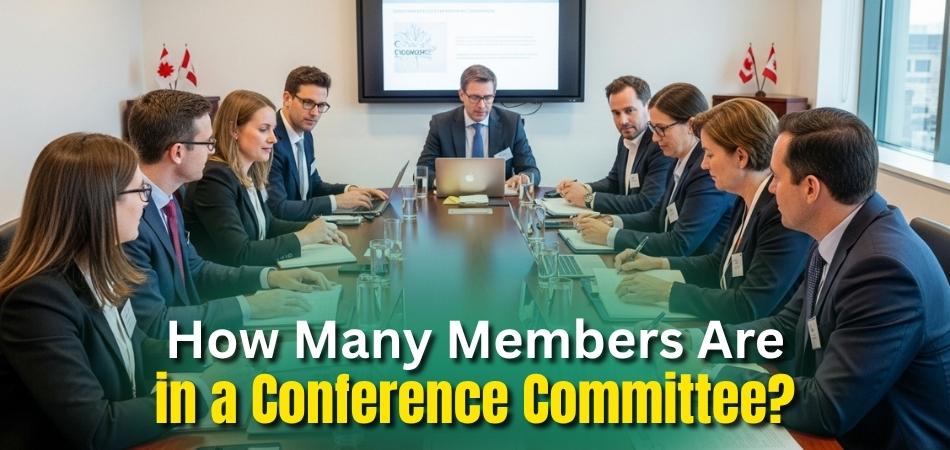Planning a conference takes teamwork, and the committee behind it plays a big role in making everything run smoothly. From managing logistics and budgets to inviting speakers and organizing sessions, the right group size can make all the difference. Too few people may lead to overload, while too many can cause confusion and slow decision-making. That’s why finding the right balance is key.
So, how many members are in a conference committee?
A conference committee usually has between 3 to 15 members. Small events may need only 3 to 10 people, while big conferences can have 20 or more. Most often, 10 to 15 members work well because it allows sharing tasks and ideas without making the group too large to manage.
The details of this deal will be explained as you read on.
How Many Members are in a Conference Committee?
A conference committee usually has 3 to 15 members, depending on the event’s scale and requirements. Small conferences need 3 to 10 members to handle essential duties without creating unnecessary complexity. Larger conferences can sometimes require 20 or more members to effectively distribute many responsibilities. Here are the factors that influence the size of a conference committee

Scale of the Event
Conference size plays a big role in deciding how many committee members are needed. Smaller gatherings with limited attendees can usually be managed by 3 to 10 dedicated members, while large events with thousands of participants may need 15 or more to share responsibilities. Balancing the workload helps ensure no one feels overwhelmed by the scale of tasks.
When planning, organizers must carefully consider the number of attendees expected during the event. More attendees usually translate to more responsibilities, including logistics, registrations, and participant support. Committees in larger events must expand their membership to ensure coverage of all necessary functions. A balanced approach ensures efficiency while maintaining strong communication between members handling different responsibilities.
Budget and Resources Available
Available funding often determines how many people can realistically be part of a committee. A larger budget allows for more members and specialized roles, while limited resources require committees to work efficiently with fewer individuals handling multiple responsibilities. Budget allocation directly affects structure and overall performance.
Organizers must analyze whether their financial resources allow expansion of the team. More members mean increased costs, including compensation, travel allowances, or resource sharing. A smaller committee may stretch resources but sometimes risks overwhelming members with excessive responsibilities. Careful financial planning ensures both manageable expenses and an effective balance of skills across the team.
Complexity of Responsibilities
Conference requirements often dictate how many members are needed. Smaller events might only need help with venues, speakers, and registration, but complex conferences demand specialized subcommittees for sponsorship, marketing, technology, and academic review. The broader the responsibilities, the more members are essential for success.
Dividing responsibilities among multiple members ensures efficiency and expertise within each area. For example, academic conferences often require specialized reviewers for evaluating paper submissions. Large-scale business events may require distinct committees for marketing, partnerships, and media management. Aligning member count with task complexity ensures proper distribution and prevents burnout within the team.
Experience of Committee Members
A committee composed of experienced individuals may effectively operate with fewer members. Skilled professionals often manage multiple responsibilities confidently without needing a large supporting team. However, if members are less experienced, additional people may be necessary to fill critical knowledge gaps. The level of expertise available shapes how many individuals are needed overall.
Experienced committees streamline decision-making by relying on established practices and prior event knowledge. They often avoid miscommunication and unnecessary delays that occur with larger, less experienced groups. Conversely, a committee of new members requires extra support, sometimes doubling its size. Matching experience levels with event needs prevents both underperformance and unnecessary overstaffing.
Type of Conference
The nature of the conference also determines how many members should be on the committee. Academic conferences often need specialists to review research submissions and handle scholarly discussions. Professional business conferences typically require marketing experts, sponsorship teams, and partnership coordinators. Cultural or community events may need larger teams for logistics, entertainment, and volunteer coordination.
Each type of event creates unique demands requiring tailored committee structures. Academic gatherings rely heavily on peer-review processes and professional integrity, often requiring specialized members. Business conferences focus more on networking, partnerships, and sponsorships, demanding roles dedicated to external communication. Cultural events often emphasize inclusivity and engagement, needing committees that can manage diverse community-focused activities.
Geographic Scope
When conferences involve participants from multiple countries, the committee size often expands significantly. International events require additional subcommittees to handle visas, travel, translation, and cultural considerations. Regional conferences within a single country can usually function with fewer members. The broader the geographic reach, the greater the administrative needs and required committee members.
For example, conferences in USA often draw participants globally, similar to events in countries like Germany or Singapore. These locations demand larger committees to accommodate diverse cultural expectations and international logistics. Meanwhile, smaller local events may require fewer individuals, as travel and language complexities are minimized. Tailoring committee size to geographic scope helps maintain smooth participant experiences across regions.
Timeline and Deadlines
The available time to plan a conference influences how many committee members are necessary. A long planning period allows a smaller group to accomplish tasks gradually. Conversely, short timelines often require more members to handle multiple tasks simultaneously. Deadlines drive the urgency and directly impact the committee structure.
Committees working with extended deadlines can function effectively with fewer people. Tasks are spread out, allowing members to dedicate more attention individually. However, events with tight timelines require dividing responsibilities quickly to avoid last-minute stress. The timeline’s intensity, therefore, plays a major role in determining overall committee size and efficiency.
Roles and Responsibilities of Committee Members
Planning a conference requires many individuals working together, each handling a role that ensures smooth organization and successful delivery. Every position within the committee carries clear responsibilities that guide different aspects of the event. Let’s understand these roles to learn how a well-structured team can create an impactful and memorable conference experience.
General Chair
- The General Chair leads the group and makes sure everyone follows the plan. They guide meetings, set the agenda, and keep the vision clear.
- They also talk with outside partners and help solve problems. Their work keeps the event on track.
Finance Chair / Treasurer
- The Finance Chair handles money, tracks spending, and makes sure bills get paid. They keep records safe and updated.
- They also deal with taxes, reports, and audits. Their careful work protects the budget from problems.
Program Chair
- The Program Chair makes the schedule and plans the main content. They look after calls for papers and reviews.
- They also pick speakers and place sessions in the right order. Their work gives value to the audience.
Publications Chair
- The Publications Chair creates and checks all conference papers, programs, and abstracts. They work closely with authors and printers.
- They make sure everything comes out on time and without mistakes. Their role shows the event’s quality.
Publicity & Public Relations Chair
- This Chair builds awareness by handling ads, media, and social posts. Their plans help people notice the event.
- They also manage outreach to attendees and branding. Their work helps more people join the conference.
Speaker Logistics Coordinator
- This Coordinator arranges travel, collects bios, and manages details for speakers. They make speakers feel supported and cared for.
- During the event, they give on-site help and send follow-ups. Their efforts make speakers feel welcome.
Exhibitor & Sponsor Chairs
- These Chairs deal with sponsors and exhibitors, building lasting ties. They arrange spaces and keep partners happy.
- They also make sure deals and branding run smoothly. Their work helps raise funds and trust.
Volunteer Chair
- The Volunteer Chair finds, trains, and guides volunteers. They help assign jobs and explain tasks clearly.
- They also cheer volunteers on and thank them for their help. This keeps morale high.
Marketing & Printing Coordinator
- This Coordinator prepares flyers, ads, and printed items. They make sure the materials are ready and correct.
- They also run campaigns that boost event reach. Their focus makes the conference look more professional.
Committee Coordinator and Shared Purpose
- The Committee Coordinator brings all members together, making sure tasks are done and plans move forward.
- This role shows the true purpose of a conference committee; each role adds to one clear goal.
Challenges of Too Few or Too Many Committee Members
Managing a conference committee requires finding the right balance in the number of members. Too few members create extra pressure and heavy workloads. And too many members bring confusion, slower decisions, and overlapping responsibilities. Here’s how both situations can impact the success of a conference.
- Heavy Workload: With very few members, each person carries multiple tasks, which increases stress, reduces focus, and often harms productivity and quality.
- Limited Ideas: Small committees often lack fresh perspectives, reducing creativity and problem-solving abilities, which weakens planning outcomes and overall event experience.
- Decision Delays: Larger committees can slow choices, as multiple voices compete for attention, creating confusion, unnecessary debates, and reduced timely decisions.
- Task Overlap: When many members join, roles overlap, which causes duplication of efforts, wasted energy, and disorganized teamwork during event planning.
- Communication Issues: Too many people often make messages unclear, leading to misunderstandings, repeated instructions, and difficulty maintaining effective group communication channels.
- Engagement Drops: Excessive members sometimes disengage because responsibilities feel unclear, leaving individuals less motivated and struggling to contribute meaningful support.
- Conflict Growth: Big groups often lead to personal disagreements, power struggles, and clashing views, which create tension and slow progress.
- Burnout Risk: Smaller groups face higher risks of burnout as fewer individuals must handle demanding workloads without enough rest or relief.
Benefits of Having the Right Number of Committee Members
A conference works well when the team behind it feels balanced and organized. The number of members matters a lot because too few people means extra stress, and too many means unnecessary confusion. When the count feels just right, everyone has clear space to work. Here are the benefits of having the right numbers.
Better Teamwork
With the right number of members, teamwork becomes smoother and more enjoyable. Everyone knows their role and feels confident about contributing. Too many voices can get messy, but balance keeps the group calm and effective. This helps ideas flow naturally without anyone feeling lost.
Clear Responsibilities
A well-sized committee makes responsibilities clear for each person. Members don’t have to wonder about overlapping tasks or double work. When jobs are divided properly, everything gets done on time without too much stress. Clear tasks also create a stronger sense of responsibility.
Faster Decisions
Making decisions gets much easier when there is the right number of people in the group. Small groups may lack enough opinions, while very large ones can take too long to decide. A balanced number brings healthy discussion without endless arguments. This means quicker solutions and smoother planning.
More Creativity
A balanced committee encourages more creativity because different voices can be heard clearly. If there are too few people, ideas may run dry. If there are too many, unique suggestions may get lost in the noise. With the right balance, creativity feels natural and effective.
Strong Communication
Communication is much stronger when the group has neither too many nor too few members. Smaller groups sometimes overload individuals with tasks, while larger ones lose track of important messages. Balance makes it easier to share updates. It also ensures everyone stays connected without confusion.
Better Planning
The right number of members helps the group make smarter plans for the event. Balanced committees divide tasks evenly and stay organized. This prevents both burnout and unnecessary delays. For example, you might see a scientific committee explained as an example of how balanced planning makes complex events run smoothly.
Less Stress
When committees have the right size, stress levels stay lower for everyone. Fewer members mean too much pressure, while too many cause delays and frustration. Balanced teams spread out the work in a fair way. This makes planning less tiring and more enjoyable.
How to Select Members for a Conference Committee?
Selecting members for a conference committee is an important step that shapes how the event will turn out. The right mix of skills makes planning easier and more effective. Wrong choices may lead to stress and confusion. Careful selection ensures balance, teamwork, and a successful outcome. Here are the ways to select members for the committee.
- Check Experience: Look for people who have already handled similar events because they bring useful knowledge. Their background helps solve problems quickly and effectively.
- Balance Skills: Include members with different strengths so every area gets covered. A mix of finance, planning, and communication skills works best.
- Strong Commitment: Choose individuals who can give enough time without distractions. Reliable members always complete assigned tasks with consistency and care.
- Good Teamwork: Find people who work well in groups and handle differences respectfully. Cooperation makes discussions easier and planning much smoother.
- Clear Interest: Invite those who show genuine interest in making the event successful. Enthusiasm keeps energy high and motivates other committee members.
- Defined Roles: Assign roles clearly while selecting members, so no one feels lost. Clear responsibilities reduce confusion and improve overall performance.
- Trust Factor: Pick members who can be trusted with decisions and responsibilities. Trust builds confidence among the team and prevents unnecessary conflicts.
Frequently Asked Questions About the Number of Conference Committee Members
A conference committee works best when it has the right number of members. The group size can shape teamwork, planning, and decision-making. Here are some common questions people ask about the number of members in a committee.
Why Does Committee Size Matter?
Committee size matters because it affects decision-making speed, workload sharing, and communication quality. A smaller group can be efficient but might lack diversity, while a larger group may bring ideas but risk slower progress if coordination becomes difficult.
Can Committee Size Change During Planning?
Yes, committee size can change depending on evolving needs during planning. Additional members may join when tasks increase, or the group may reduce if responsibilities lessen. Adjusting numbers helps maintain efficiency without overloading individuals or complicating communication unnecessarily.
Do Virtual Committees Need More Members?
Virtual committees may benefit from slightly more members since tasks are spread across different time zones. More people can ensure better coverage and flexibility, but balance remains important to avoid confusion, duplicated work, or difficulties in reaching timely agreements.
How Does Committee Size Affect Creativity?
Committee size impacts creativity by determining how many unique perspectives are included. Smaller groups may generate fewer ideas, while larger groups provide broader input. The right balance ensures brainstorming is productive, fresh ideas are encouraged, and discussions stay organized effectively.
Should Student Committees Be Smaller?
Student committees often work better with fewer members since students juggle classes, exams, and personal commitments. Smaller groups allow clearer communication and easier coordination. The focus is on manageable tasks, so responsibility feels fair without overwhelming the members involved.
Are Larger Committees More Costly?
Larger committees can increase costs due to higher needs for resources, meetings, and management. Every extra member may require support, training, and coordination. Balancing size helps control costs while still ensuring enough people are available for essential responsibilities.
How Does Committee Size Impact Leadership?
Leadership becomes more complex as committee size increases because managing larger groups demands stronger coordination. Smaller committees make it easier for leaders to communicate and guide directly. Finding the right size ensures leaders stay effective without being stretched too thin.
Can Committee Size Influence Event Success?
Yes, the number of committee members can influence the success of an event significantly. Too few members may limit capabilities, while too many create confusion. A balanced committee ensures tasks are handled efficiently, goals are met, and success feels achievable.
Bottom Lines
A conference runs well when the team behind it is balanced and organized. Too few members often bring extra stress. Too many members can slow down decisions and create confusion. Finding the right number makes planning smoother and sharing tasks easier.
The answer to how many members are in a conference committee depends on the size and type of event. A small event may only need a handful of people, while bigger ones need more. Choosing the right members with clear roles builds teamwork, reduces pressure, and helps create a successful and enjoyable conference.







